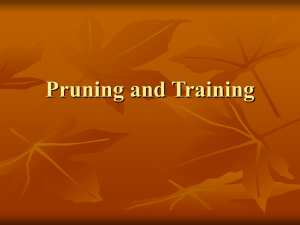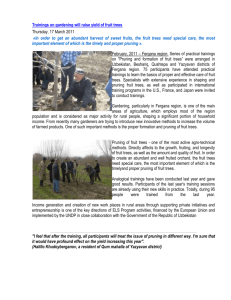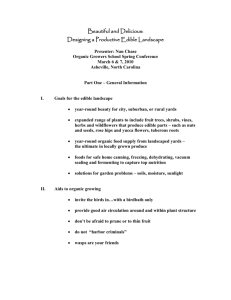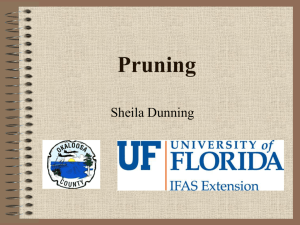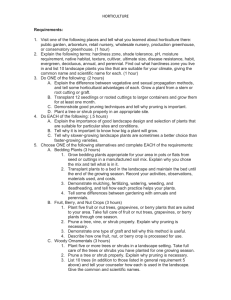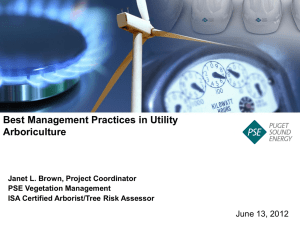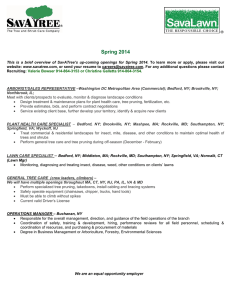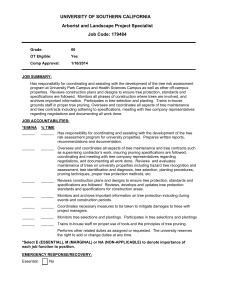PRUNING FRUIT TREES IN KANSAS
advertisement
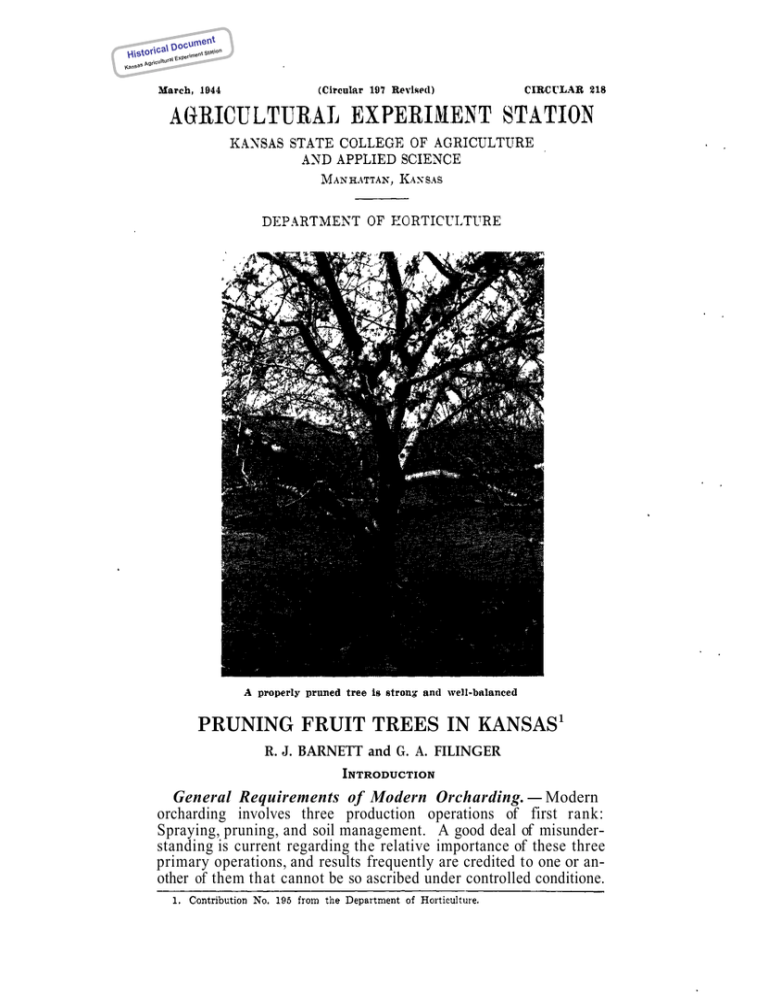
t cumen cal Do Histori Kansas riment Expe ultural Station Agric PRUNING FRUIT TREES IN KANSAS1 R. J. BARNETT and G. A. FILINGER INTRODUCTION General Requirements of Modern Orcharding. - Modern orcharding involves three production operations of first rank: Spraying, pruning, and soil management. A good deal of misunderstanding is current regarding the relative importance of these three primary operations, and results frequently are credited to one or another of them that cannot be so ascribed under controlled conditione. Kansas t cumen cal Do Histori n t Statio perimen ral Ex ricultu Ag But it may be taken as a general rule that lack of care regarding any of these three will greatly reduce the value of the orchard and the crop. These three operations are closely related and demand the grower’s attention, each in its proper degree and season. All being essential to the success of the undertaking, none can be placed in a dominant position over another. Pest control and careful soil management combined with skillful pruning constitute the only sound foundation for successful fruit production. Definition of Pruning.- Pruning may be defined as the removal of a part of a plant for the purpose of increasing the economic value of the remainder. This increase in value may be merely the greater probability of the plant’s living; it may consist in the building of a larger or stronger tree or bush; fruitfulness may be increased; or it may be merely an aid to other orchard operations, as spraying and harvesting. Without exception, however, the grower does better pruning when he understands the particular purposes toward which his efforts are directed and the physiological effects which may be expected to follow whatever cutting he does. Bearing Habits of Fruit Trees.-The grower must understand, also, something of the method of fruit bearing of the plants which he prunes. He should know the fruit spurs of apple and pear and realize that they are the tree’s machinery for fruit production; that two or more years are required for their development; that they will be unfruitful, or even die, if overshaded; and that when once lost on any part of the tree they can never be replaced there but must be produced farther out on the tree. In contrast with this habit, that of the peach and of some of the sour cherry varieties may be mentioned. With them the principal part of the crop is borne from buds on the twig growth of the preceding summer, and so the production of twigs must be encouraged. Still another method of fruit bearing is to be found in the case of the grape, the bramble, the persimmon, and the quince. None of these plants carry separate fruit buds over winter, but all bloom and bear their fruit on shoot growth of the current season, which arises from lateral buds formed the preceding summer. An accurate conception of such facts is a necessary part of the working knowledge of one who would prune fruit plants intelligently. Some of these methods of fruit bearing are illustrated in Figure 1. Individuality of Fruit Trees.-A clear understanding of the fact that both varieties and trees within the variety have individuality and that each requires special treatment, is of great use to the pruner. A system which proves successful with the Jonathan apple might not apply in the case of an upright-growing apple tree like the Rome; so, although something resembling a system of procedure in pruning may well be adopted, the worker must keep constantly in mind the necessity of adapting his “system” to the peculiarities of varieties and even of individual trees. Kansas tural Agricul t cumen cal Do Histori ion ent Stat Experim Influence of Climate and Soil.-The fact that different kinds, and even different varieties of the same kind, of fruit trees require pruning methods adapted t o their individual peculiarities, especially while young, has been mentioned. Reference must also be made to two other factors which may still more strongly affect tree growth habit; i.e., the climate and the soil. Pruning t o counteract deformity due to wind has been given much study, but the opinion now seems to be general that a windbreak is a better solution. Sunscald on the trunks and large branches of young trees can usually be prevented by low heading and the avoidance of too heavy pruning. Soil exerts a dominant influence over the shape of young trees. If the soil is fertile and the moisture supply adequate the tree will make a rapid, vigorous wood growth and may then be shaped to fit the grower’s ideal. But no amount or any system of pruning can rectify bad shape in a tree which is making but a feeble growth due to infertile soil. The first step in correcting a poor habit of growth of a tree so situated is to supply it with an abundance of soil moisture and available nutrients. After such treatment has stimulated the tree into vigorous growth the usual pruning practices may be expected to succeed in bringing it to proper shape. Some Definitions.-In order to learn about pruning from the printed page the writer and the reader must agree regarding the meaning of terms used in describing the process. The collar of the tree is the point of union between the root and the trunk. The trunk extends from the collar to the first subdivision of branches. The leader in a fruit tree is the central, upright-growing stem, a direct continuation of the trunk. The framework or scaffold branches are the series of branches originating directly from the leader. From these arise the secondary branches. Stems beyond the secondary branches are potential fruit-bearing wood. It may consist of terminal stems of the preceding season’s growth, called twigs, or of spurs. Spurs are borne laterally on stems which are two or more years old. Leaves appear only on twigs and spurs. These parts of fruit trees are illustrated in Figures 1 and 2. The three principal operations connected with pruning are heading back, thinning out, and the removal of large branches. Heading back consists of cutting off a portion of a twig or branch. It more commonly applies to twigs and is a part of the training of young trees. Thinning out refers to the removal of twigs or small branches which are growing too close together. It is practiced throughout the life of the tree. Large branches are removed when they become broken, diseased, or crowded, and in rejuvenation pruning. Heavy pruning of fruit trees may be considered as any pruning in which wood equal to one-fourth or more of the annual twig growth is removed, while light pruning would be the removal of wood amounting to less than one-fourth of the annual twig growth. A third class, medium pruning, might be made, and would include the Ka ricul nsas Ag t cumen cal Do Histori n t Statio perimen tural Ex removal of one-eighth to one-fourth of the annual growth. These distinctions are somewhat arbitrary and the amounts named relate to trees which have had regular attention in the way of pruning and are making normal growth. Moderation Recommended in Pruning.- Fruit growers have suffered severe losses due to using extreme methods in pruning. Too heavy pruning upsets the balance between the top of the tree and the root system and results in various ill effects, such as unduly delaying the establishment of fruit production, the dwarfing of the t cumen cal Do Histori Kansas riment ral Expe ricultu Station Ag tree, and, usually, its earlier decline and death. Neglect of pruning and too light pruning are also injurious. They lead t o overheight of trees, making picking and spraying more expensive; to undue density of top and consequent poor color of fruit; to overbearing, a cause of small fruit and of the biennial habit; and to a general dominance of the vegetative over the reproductive functions of the trees during the middle period of their lives. For these reasons the medium course in pruning is recommended. t cumen cal Do Histori Kansas riment Expe ultural Station Agric Large trees are desirable but they must not be so large as greatly to increase the expense of orchard operations. Vigorous-growing trees are the most valuable, but they must not be so vigorous in wood growth as to defeat the object for which they are grown; that, is, fruit yield. Productive, heavy-bearing trees are requisite for profit, but they should not be so fruitful that they bear themselves to death in a few years, a s occasionally happens. Moderate annual pruning is of vastly greater value than irregular, heavy pruning. The best pruning is that which is done in the light of a knowledge of its probable results; of the physiological principles which underlie the work; of the local climatic and soil influences; of kind and varietal peculiarities; and of the importance of the regular, well-planned application of this knowledge. Pruning so done assumes a value which entitles it to rank as equal in importance with spraying and soil management. Time for Pruning Fruit Trees.-The old adage, “Prune when your knife is sharp,” better fitted the day of amateur fruit growing than the commercial orchard of today. The time for pruning is now set by economic considerations and the observed effects on the pruned tree. Both of these tests indicate that nearly all pruning of fruit plants should be done while the plants are dormant, after the leaves have dropped in the fall and before the buds open in the spring. Favorable weather for this work usually occurs in Kansas during the three winter months, and the owner himself will then be able to do the necessary pruning in about 20 to 30 acres of young orchard. Some exceptions t o the rule of pruning during the winter months only could be cited. Pruning of fruit plants which are tender to low temperatures may be delayed until the hazard of winter injury is past, usually in early March. I n some sections, pruning of peach trees may be postponed until the prospect for a crop is known. If the blossoms are killed, more wood should be removed from trees of bearing age. t cumen cal Do Histori Kans riment ral Expe ultu as Agric Station PRUNING FRUIT TREES 7 GENERAL DIRECTIONS The art of pruning fruit trees can be comprehended best if the discussion of it, as well as the actual work, be divided into two rather definite parts. The first of these, which would include all pruning done between the time the trees are set and the time they come into bearing, may be called “Pruning for Tree Building.’’ This process is, in many ways, in sharp contrast with the subsequent phase, which may be termed “Pruning for Tree Maintenance and Fruit Production.” PRUNING FOR TREE BUILDING Building the Framework.- The object in the mind of a grower while pruning for tree building should be the production of trees that are strong; that are large though low; and that will come into bearing a t a proper age. The mechanical strength of a tree, its ability to support a heavy load of fruit, depends on two principal features: (1) The correct formation of the framework, and (2) the stockiness of the wood. The arrangement of the low framework limbs is usually determined a t the time of the second pruning following the graft. Care a t this pruning to select branches that are evenly spaced around the trunk and that are distributed eight inches or more apart vertically usually will yield a tree which will not split a t this point. Strong and weak crotches are illustrated in Figure 3. However, the preservation of a central leader for a number of years Ka ricul nsas Ag t cumen cal Do Histori n t Statio perimen tural Ex still further strengthens this weakest part of most fruit trees. Stockiness of branch is encouraged somewhat by heading back, but treatments which will increase the vegetative activity of the tree are of greater value. Pruning for Size.-Heavy yields of fruit are obtained only from large trees. The avoidance of over pruning is the principal precaution t o be observed in order to produce such trees, provided the soil is fertile. It is probable that no pruning at all would result in the largest trees, but they would be defective in so many ways that this practice has little else t o recommend it. Persistent heavy pruning dwarfs fruit trees because it greatly reduces the total leaf area of the tree, and consequently the elaboration of plant food. Large trees must be prevented from becoming too high by judicious head- Kansas t cumen cal Do Histori n t Statio perimen ral Ex ricultu Ag ing back of upright-growing branches and by encouraging, through lighter pruning, those which tend toward the horizontal. Pruning and Fruit Bearing.- The age a t which fruit trees begin to bear is largely an innate characteristic and can be influenced by pruning within only rather narrow limits. I n a general way, heavy pruning delays the beginning of pruit production because i t prevents storage of starch early in the growing season and diverts the activities of the tree to the production of wood to replace that removed, especially if this heavy pruning is done during the dormant season. However, light pruning, or even no pruning, seems to have but little effect in hastening fruit bearing-the kind of fruit, variety, soil, and climate probably being the principal factors governing early maturity. The First Pruning.- In most parts of Kansas one-year-old fruit trees are more valuable for starting an orchard than are older ones. Grafted apple and pear trees of this age will usually be straight switches, but others, as the peach and cherry and budded apple and pear, will have lateral branches. The root system of the transplanted tree may need attention. Broken or badly injured roots may be cut back to sound wood, and if one or two roots are much longer than the others they should be cut back to average length. Straight-switch trees require only heading back a t the time of setting. A glance at Figure 4 will make this operation plain. The cut should be made a t a height of about 30 inches, thus allowing for a trunk of 18 to 24 inches and sufficient space above it for the distribution of the framework branches. The pruned switch must bear a number of good strong buds on the upper 12 inches. If these buds are weak or have been rubbed off, the tree should be thrown away. If two-year-old trees or branched yearlings are planted, they are headed back a t about the same height as unbranched trees, though the leader may be left somewhat longer if the branches arising from it are vigorous and stocky. The framework branches are then chosen and are headed back severely, to but one plump bud if the trees show any signs of weakness, and all other branches are cut away close to the main stock. Strong two-year-old trees having good root systems may be pruned in the manner described for “the second pruning,” except that the lateral branches should be more severely headed back. The recommendation of one-year-old trees for planting in Kansas and their heavy pruning immediately after planting is based on a knowledge of what happens to the roots of a young tree when dug from the nursery row, and long experience with the vagaries of Kansas weather. When a young tree is taken from the soil in which it has grown one or more years, a large part of its more efficient roots is left behind and the natural balance between the leaves and the water-absorbing roots is upset. Reduction of the tops through pruning tends to restore this balance. Trees transplanted in March are sometimes subject to injury due to dry soil a t that time or to spring drought in April or May. Either of these hazards is lessened t cumen cal Do Histori ultural Agric Kansas ion ent Stat Experim if the water requirement of the young tree is temporarily reduced by the removal of a large part of the tops which would later bear leaves. If the soil is moist to a depth of three feet at planting time and no drought is expected, lighter pruning would be recommended. The Second Pruning.- After making its first summer’s growth the young tree is again pruned during the dormant period. This is t cumen n io cal Do Histori tural Experiment Stat Kansas Agricul the most important pruning that the tree will undergo. It involves the choice of the first framework branches of the future tree. These should be two or three in number, of nearly equal strength, and well distributed both around and up and down the main stem. After selecting those to be saved all other twigs are cut off close to the central stem. Those preserved are then headed back t o about 18 inches in length. The central one of the twigs left on the tree will be upright in its growth and will continue as the leader in the tree. It should be left slightly longer than the other branches a t this pruning. Figure 5 illustrates this operation. The Third Pruning.-One year later the tree will receive its third pruning. This will be similar to the second and consist of both thinning out of twigs and heading back of those which remain. These latter will be about twice as numerous as the first series from which they arise, and are known a s secondary branches. They should be headed back in proportion t o the growth they have made. Great care must be exercised to space the branches as well apart on the scaffold limb as is possible and to head them back to unequal lengths. Many of these pairs of branches would form acute angled and weak crotches if headed back to equal lengths. The difference in length should be as much as six or eight inches. No secondary branch should be established on a scaffold limb closer than 15 inches from the point of origin of the scaffold limb. Lateral twigs will have grown from the lower portion of the leader. From these, two or more should be selected as framework branches and the others removed. These new framework branches should be of good vigor and so distributed around the leader that they will fill in the horizontal spaces between those established a year earlier. They should be well distributed along the leader and headed back to about the same height as the older framework branches. The leader is headed back just a little higher than the tips of the other branches. The method of the third pruning is shown in Figure 6. The Fourth Pruning.- The fourth pruning will follow the third year’s growth in the orchard. It is, in general method, similar to that of the preceding year and will result in an approximate doubling of the number of branches in the tree. The same degree of care must again be exercised in choosing the new twigs which are t o become permanent parts of the tree, to avoid weak crotches and t o induce a symmetrical growth of the whole top. The leader will still be allowed to persist, but any tendency to outgrow the other branches must be counteracted by heavier heading back and by leaving a larger number of small twigs on it. Later Prunings.- Subsequent prunings are similar to those described except that, as the time when the tree should begin to bear fruit approaches, general heading back of the twig growth will be discontinued and thinning out of branches will be restricted to those which are superfluous, grow across the tree, are diseased or dead, or tend to throw the top of the tree out of balance by too t cumen cal Do Histori Kansas riment Expe ultural Station Agric exuberant growth. At this stage the tree begins to develop fruit spurs, if apple or pear, and will begin to set fruit buds, if peach. The years between the ages of four and seven for early-bearing kinds and varieties and six and nine for those which are later in coming into bearing are critical periods in the development of the trees. Most growers wish t o have the orchard come into bearing a t the earliest possible age, and under favorable climatic and soil con- ditions this is to be desired. There is, however, a general rule that a close correspondence exists between the time a t which a fruit tree begins to bear and the length of its productive life. Early bearing is linked with early decline and late bearing with a long productive period. A gradual change from pruning methods adapted to young trees to those better suited to bearing trees should be made during this period. It involves the substitution of branch removal for almost all heading back and a general decrease in the relative amount of wood removed. t cumen cal Do Histori Kans riment Expe ultural as Agric Station PRUNING FOR TREE MAINTENANCE AND FRUIT PRODUCTION This portion of the discussion of pruning relates in point of time to the productive years in the life of the tree. The juvenile period has passed and the objects which the grower then had in view no longer govern; the vegetative stage has given way to the reproductive stage and pruning methods must be varied to correspond. The New Objects.-Now that the fruit-bearing habit has been established, the objects sought through pruning have taken on a different character. First, maximum production of high-grade fruit is desired. Second, the trees must make sufficient annual twig growth to produce the needed leaves to nourish the fruit and maintain the vegetative vigor of the tree. Third, the size, including the height, and the density of the tree must be regulated. Pruning for Fruit Production.- The relative value of winter and of summer pruning for the promotion of fruitfulness cannot be fully discussed here. Results of experimental work in this problem, carried on in many parts of the country, have been conflicting. It seems best in the light of our present knowledge t o do most of the ordinary pruning while the trees are dormant. If summer pruning is done, the time should be soon after the principal twig growth has been completed and the method similar to that employed during the dormant period. Pruning, whenever done, should be so performed as to raise the grade of the fruit. It may assist in thinning the fruit, thus increasing the average size, will result in much better color on apples and peaches, and will, due to the more even admission of sunlight, delay the loss of spurs and bearing twigs on the interior of the tree. Pruning to Promote Vigor.-The use of pruning for the purpose of increasing the vigor of fruit trees is limited. It forms a part of all rejuvenation work but must be combined with soil improvement measures and general good care to result in any lasting benefits. That heavy pruning promotes vigorous wood growth on the pruned parts of the tree is generally true, but i t may at the same time do many other less desirable things. It may cause the growth of many water sprouts and suckers which will have to be removed; i t increases the danger from sun scald, and i t may interrupt the tree’s established habit of fruit bearing. Pruning to Regulate Size and Shape of Tree.-Maintenance pruning is done, in large part, to keep the trees in proper size and shape for both maximum and economical fruit production. The size, in spread of branches, which orchard trees may be allowed to attain is governed by the planting distance and the natural development of the variety under the soil and climatic conditions prevailing in each orchard. The planting distance should permit the trees to attain their full horizontal growth without any interlacing of their branches or undue interference with orchard operations, such as harvesting and spraying. When such interference does arise, the pruning, year after year, must include some heading back of hori- t cumen cal Do Histori Kansas riment ral Expe ricultu Station Ag zontal terminals to confine each tree to its own area. The height must also be controlled. This is done by cutting the upright growing leaders back to strong lateral growing branches. This prevents the formation of a higher story in the tree, and should be so managed as to keep all of the fruit-bearing wood within 20 feet of the ground. Methods of Maintenance Pruning.- The actual operation of maintenance pruning will differ from that previously described for tree building in two main particulars, namely, the heading back of twigs will have almost entirely ceased and the removal of large branches will occasionally be necessary. I n the latter work, care must always be exercised to make a neat, smooth wound and a t the proper place. A large wound, smooth and so located that the sap flow of the tree will reach all parts of its margin freely, will heal over more quickly than a smaller one poorly made and located too far from an abundant supply of food. Pruning “stubs” should never be left. Figure 7 illustrates the removal of a large branch without danger of splitting the wood of the tree trunk. Care must also be taken when removing an upright-growing branch to make the angle of the cut such as not to weaken the wood to the extent that the weight of the lateral branch just below the wound will later cause the main stem to split and break down a t this point. A light thinning out of small branches two to four years of age will be needed at each pruning. These slender horizontal or drooping branches produce practically no marketable fruit and tend to interfere with the bearing of better-placed stout branches. At the same time crowded, crossing, diseased, dead and broken branches are removed. These cuts should be made carefully and close to the wood from which the t cumen cal Do Histori Kansas riment ral Expe ricultu Station Ag branch is removed. The removal of all water sprouts and sucker growth requires attention also. The latter must be cut off close to the collar of the tree or the root and never at the surface of the ground. If water sprouts are removed early in the summer before they become woody, they can be snapped off by hand very quickly, thus saving considerable cutting when the dormant season pruning is done. When neglected they are favorite breeding and feeding places for woolly aphids. Relation of Pruning to Pest Control.-General directions on pruning always recommend the removal of diseased branches. This is usually good policy and needs emphasis, but cannot be fully explained in this circular. It may be stated, however, that the more important diseases the control of which involves pruning are fire blight of the pear and apple, blister canker, blotch and black rot of the apple, and black knot and pockets of the plum. Wood infested with any of these diseases should be removed well below the site of the lesion and the prunings quickly and carefully burned. Bulletins which discuss the control of these diseases should be consulted. For this type of pruning the disinfecting outfit described on page 16 should always be available and used. Early removal of water sprouts aids in the control of aphids, as these insects prefer the shaded and protected parts of the tree. PRUNING TOOLS AND THEIR USE Necessary equipment in the way of pruning tools needs be neither complex nor expensive. It pays, however, to get the best when buying such implements and then to take good care of them. The Implements.- A supply of pruning tools for each workman should include one tapered swivel saw with a number of spare blades, hand-pruning shears, 24-inch lopping shears, pruning knife, selfsupporting ladder and a disinfecting kit. Careful, experienced workmen may find a pole pruner or a pole saw a time-saving tool, but either implement in the hands of a careless or inexperienced worker can cause much damage to a tree. Good types of some of the implements mentioned are illustrated in Figure 8. The Proper Use of Pruning Tools.-The hand shears and the knife are used to remove branches not more than three-fourths of an inch in diameter. With either of these implements the work can be better and more easily done if the left hand assists in making the cut by keeping the tissue just ahead of the edge of the blade under a strain. The knife is also used to smooth off rough wounds made by the saw or lopping shears. The saw may be used in removing all larger branches. The blade should be kept sharp and tight and every care exercised to make smooth, even wounds, nearly parallel with and close t o the limb from which the branch is being removed. Branches as large as one and one-half inches in diameter may be removed by the lopping shears. The pole pruner is used for branches high in the tree or out at the tips of the horizontal branches. It should never be used in cutting branches more than three-fourths of an inch in diameter. t cumen n io cal Do Histori tural Experiment Stat Kansas Agricul Practical pruners differ regarding the use of the ladder, but one of the self-supporting type is convenient and lessens injury when pruning high trees. A good type of orchard ladder is illustrated in Figure 9. Equipment f o r Disinfecting. - Equipment for disinfecting wounds and pruning tools should always be at hand if the presence of fire blight or blister canker is even suspected in the orchard. The outfit will consist of a wide-mouthed bottle containing the following solution: A swab can be made by wrapping a number of thicknesses of cotton cloth around the end of a 12-inch stick. The swab is dipped in the disinfectant and the blade of the pruning tool, as well a s the wound, is thoroughly moistened after removing a diseased limb and before starting work on another tree. This is much less bother than a description of it indicates, and should never be omitted. The chemicals may be obtained through any drugstore and will have attached directions for making the proper dilution. CAUTION! These chemicals are violent internal poisons, but will not injure the skin of the hands by contact. The supply and the container should be labeled and carefully guarded. Pruning-wound Dressings.-The rate at which wounds on fruit trees heal over is governed by the kind of tree i t is and its vigor. Ka t cumen cal Do Histori ricul nsas Ag n t Statio perimen tural Ex Wounds on apple and pear trees heal rapidly while similar wounds on cherry and peach trees heal slowly on young trees and will be slow or may fail even to start the healing process on old trees. A wound which exposes wood tissue for a year or more may become infected by various diseases if left unprotected. Blister canker and wood rots caused by fungi are most t o be feared in Kansas. A good dressing for' wounds should be nontoxic to plant tissue, durable, elastic, water-proof, antiseptic, not too expensive, and easy t o apply. Many materials have been tested but none has ranked high in all these requirements. White lead and oil house-paint has proved valuable in Kansas. It should be applied when the exposed wood is dry and it will need to be renewed a t intervals to maintain adequate protection. Shellac forms an excellent temporary cover over pruning wounds. Dressing No. 541 is recommended by the United States Department of Agriculture. It consists of rosin 8 parts and sardine oil 3 parts, and is prepared by heating together the rosin and the fish oil until the rosin is melted. It is applied melted, using a brush. Soft wax dressings often melt and drip off tree wounds when the temperature is high in Kansas. In contrast, hard waxes may crack and peel off due to low winter temperature. t cumen n io cal Do Histori tural Experiment Stat Kansas Agricul SOME SPECIFIC DIRECTIONS PRUNING THE APPLE TREE The foregoing discussion relates, in the main, to the pruning of all kinds of deciduous fruit plants, although the apple has been more particularly in the thoughts of the writers than have the others. Because of this, the statements applying specifically to the apple may be made brief. Apple trees are vigorous-growing plants, under proper environment, and require moderate annual pruning. The work should be done during the dormant period, a t any convenient time after the leaves have fallen and before the spring flow of sap. Fruit-bearing Habit.- The apple tree bears its fruit on short crooked growths known as spurs. These spurs are produced laterally on branches a t least two years of age, bear the fruit from terminal buds, and, if not starved or too heavily shaded, will continue to produce for as many as ten or twelve years. Individual spurs tend to be biennial in fruit bearing and when most of the spurs on a tree produce blossoms the same season the tree as a whole is likely to assume the alternate bearing habit. Pruning should be so managed as to prolong the productive life of the fruit spurs by keeping the tops of the trees reasonably open to the sunlight. These spurs should never be pruned off as long as they remain fruitful, except in case they are situated directly on a large branch when the danger of their transmitting fire blight to the framework of the tree may make their removal advisable. Trunk and Framework.- Under Kansas conditions 18 to 24 inches seems t o be the proper length for the trunk of an apple tree. The first set of framework branches should be distributed over a distance of 12 to 18 inches along the leader just above the trunk of the tree. It should consist of two or three well-placed limbs and, if a choice is possible, branches should be selected which make a wide-angled crotch with the leader and are evenly spaced around it. Kansas tural Agricul t cumen cal Do Histori Experim ion ent Stat Living ties to assist in strengthening weak crotches may be made in young trees by twining together interior twigs from opposing limbs. The ends of these twigs should not be cut off until after strong union has taken place between them. Figure 10 illustrates a strong and valuable living tie. I n the modified leader type of pruning, additional main branches are allowed to arise from the leader until the number reaches six or even more. These must be selected with care in order that they may be strong and so placed as to make a symmetrical tree. One or two are added each year until about the sixth year when the leader is suppressed by cutting i t off just above a strong lateral branch. Care must be taken to keep the top twigs of the lower framework branches nearly as high as those originating from the leader. Maintenance Pruning.- The pruning of bearing apple trees need not be further discussed, as the preceding general remarks on that topic apply particularly to this fruit. Moderate annual pruning, such as will admit light to the center of the tree, prevent too great height growth, assist in sustaining the vigor of the tree as indicated by annual twig growth of six to twelve inches, and tend to promote abundant fruit production, is what is required. PRUNING THE PEAR TREE The pear is a close botanical relative of the apple and bears its fruit in much the same manner. Consequently, the same general methods of pruning apply. Two differences do exist, however. The habit of growth of most pear varieties is more upright than among the apples and the fruits do not develop red color as do those of many apple varieties. The first variation indicates that greater care must be exercised to prevent the tree from becoming too high, and the second allows a somewhat more dense top to be tolerated. The danger of shading out valuable, well-placed fruit spurs is to be avoided as with the apple, however, and heavy pruning such as would tend to promote a soft, vigorous twig growth and water sprouts is never desirable because of the increased danger of fire blight attacks. PRUNlNG THE PEACH TREE The culture of the peach differs in many respects from that of the apple, and a t no point is this difference wider than in pruning. The peach orchard should not be considered a semipermanent improvement like an apple orchard. It should be pushed into early and heavy bearing and a new one started as soon as the old one begins t o decline. The tree also differs from the apple in its general habit of growth, the age a t which it begins to bear, and in its fruit-bearing habit. Bearing Habit.-The peach tree, in general, bears its fruit from axillary buds on twigs of the preceding summer’s growth. If spurs are produced, as does occur under some conditions and with some varieties, they differ from apple spurs in that they are straight and bear from 1ateral instead of terminal buds. Terminal buds on peach trees are always vegetative in character. This difference in fruiting t cumen cal Do Histori Kansas riment Expe ultural Station Agric habit indicates one of the principal distinctions between the pruning of the apple and the peach. I n the former the twigs are of value only in the general vegetative economy of the tree, and any specific treatment of them does not immediately affect fruit production. But with the latter the twigs have both vegetative and fruit-bearing t cumen cal Do Histori Kansas riment Expe ultural Station Agric functions, and their removal or their failure to grow directly affects the yield of fruit by the plant. (Fig. 1.) The location of the fruit buds on the peach twig is variable. On most young trees, and on some varieties a t any age, they are developed well toward the tips of the twigs. As the trees become older the fruit buds are formed lower on the twigs or distributed throughout the greater part of their length. The effect of this on pruning operations is manifest; the thinning out of twigs always thins the crop, but whether heading back does so or not depends on the location of the fruit buds, and must be made a matter of study in each orchard a t pruning time. Early Pruning.-One-year-old peach trees are recommended for planting. Such trees are usually three to six feet high and will have lateral branches of varying vigor. There are two general methods of pruning such trees at planting time. The most common method is to head the tree at a height of about 24 inches. Three or four lateral branches between 12 inches above the ground and the top of the tree are selected and cut back to two or three buds. The rest of the branches are removed. Such treatment will result in a lowheaded, semi-open-center type of tree that is desirable from the standpoint of harvesting, wind resistance and spraying, but since the scaffold branches are crowded, the tree may break down under a heavy load. (Fig. 12 A.) The second method is to head the young tree at a height of 36 to Kansas tural Agricul t cumen cal Do Histori Experim ion ent Stat 40 inches and cut the laterals back to one or two buds, as shown in Figure 11. Such treatment results in a somewhat higher-headed, stronger tree and will require more careful selection of scaffold branches following the first season’s growth in the orchard. (Fig. 12 B.) The method to use will depend on the preference of the grower and on the type and vigor of the trees he gets from the nursery. The longer-stemmed trees will allow the scaffold branches t o be spaced a greater distance apart and being higher-headed will permit tillage tools to work closer t o the trunks. They are less convenient for harvesting and spraying and are more subject to wind deformity. During the dormant period following the first summer’s growth the trees should be given their second pruning. This will agree with the general directions (page 7) but will involve more severe heading back of the framework branches than with other kinds of fruit trees. The length left need not be more than one foot. Should the second or third season’s growth of twigs show a set of fruit buds, which will be found as additional buds in the axils of the leaves and on one or both sides of the branch buds, the grower has a choice in methods of pruning. All twigs not needed for permanent parts of the tree may be cut away and those left severely headed back. This will build u p the strongest tree possible but will sacrifice nearly all of the first crop of fruit. The other method is t o leave a considerable number of twigs which are not needed as permanent parts of the tree and head them back but slightly. These excess twigs will produce fruit that season and should be cut out entirely the following winter. Permanent branches left at the same time should be headed back, usually below the region where they bear fruit buds, and thus prevented from moving the bearing wood of the future too far from the ground. The exact extent of heading back to be practiced in pruning young peach trees must be determined through local experience. The principal point t o bear in mind is that too severe heading back delays fruit-bearing while too light produces high, “leggy” trees which make all orchard operations more expensive. Making a correct decision in this dilemma constitutes the real test of the pruner’s skill. Pruning Older Trees.-As peach trees approach maturity constant care must be exercised to keep the tops open to the sunlight If this is done by judicious annual thinning out of young wood, the tree will be kept low in stature and vigorous bearing wood will be retained in the lower interior parts of it. Low-hanging peach branches are of but little value. The fruit they may bear is poor in quality and color. Hence the pruner’s attempt should be to keep the shape of the tree such that the framework branches will be somewhat upright, forming an angle of about 45 degrees with the central shaft of the tree. The top should be kept well open to sunlight and spray materials. All leaders should be subdued and their vigor directed into more horizontal growths. Deheading.- Under certain conditions money has been made by “deheading” old peach trees and inducing them to grow new tops. t cumen cal Do Histori Kansas riment ral Expe ricultu Station Ag This is usually done following a severe winter which kills the fruit buds. It consists in cutting all of the top of the tree back to the secondary branches. Growth the following summer may be abundant and vigorous, may be confined to only certain branches, or may fail entirely. When abundant, it will require severe thinning out and heading back during the dormant period and probably will produce fruit buds the second summer following the deheading. Because of this certain loss of two crops and the possibility of the death of the trees, serious consideration should always be given the question whether it would not be better t o grow a new orchard and, upon its reaching bearing age, remove the old one without attempting t o rejuvenate it. PRUNING THE SOUR CHERRY TREE Of all the fruit trees grown in Kansas, the sour cherry requires the least pruning, especially when i t is grown on Mahaleb stocks and when the low, spreading varieties are planted. However, the sweet cherry and the more upright-growing sour varieties on Mazzard stocks require constant attention in order to prevent their becoming too tall for economical fruit harvesting. F r u i t -b e a r i n g Habit.-The sour cherry bears fruit on spurs and also in the axils of the leaves on one-year-old wood. The spurs, as illustrated in Figure 1, are straight, the terminal bud being vegetative, in contrast with the crooked spurs and terminal fruit buds of the apple. The distribution of fruit-bearing between these two types of organs is a characteristic of varieties and should be given study by the grower. If fruit is borne on the twigs, any heading back may be a fruit-thinning process. The maintenance of the vigor of the spurs through keeping the top of the tree open is also important. Pruning Practice.-Good vigorous one-year-old sour cherry trees probably have developed lateral branches in the nursery and the choice of the framework limbs is made a t the time the tree is planted in the orchard. Planting should be as early in the spring as is possible and on fall-plowed land. The principles underlying the choice of framework branches for these plants do not differ from those already described except in number. Three or four well-placed branches rather than fewer, six to eight inches apart along the leader, are selected when the tree is pruned immediately after planting. ( F i g 13.) All others are removed. Those with wide crotches should be chosen. A trunk not more than 18 inches in length is best. The branches left to form the framework should be rather severely headed back to prevent their weakening or girdling the leader. Subsequent pruning throughout the life of the tree will consist of thinning out clusters of twigs which develop near the tips of the preceding year’s growth, the removal of crossing, rubbing, and parallel branches and all water sprouts and suckers, and the suppression of any branches which show a tendency to grow too high. This, with the removal of diseased or dead branches, is usually all that is needed, though some heading back of the twigs may be desirable while the trees are young. t cumen cal Do Histori Kans 24 riment ral Expe ultu as Agric Station K ANSAS CIRCULAR 218 FIG. 13.-A newly-set Montmorency cherry tree. It is difficult to get wide-angled crotches and correct vertical distribution of scaffold branches on this variety. 20-1775

